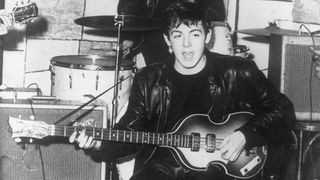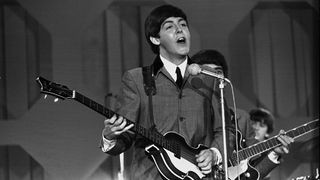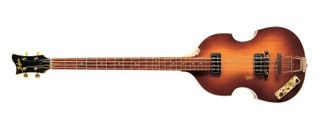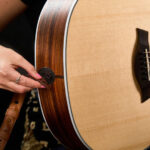Is there a more quintessential pairing in music history than Paul McCartney and his Höfner bass guitar? The mere mention of McCartney conjures images of him effortlessly wielding that violin-shaped instrument, an extension of his musical genius. It’s become so ingrained in popular culture that it’s almost impossible to picture one without the other.
The Beatles, arguably the most scrutinized band of all time, have had every aspect of their career dissected and analyzed. Among these countless examinations, McCartney’s relationship with his Höfner basses has been a recurring subject of fascination. This intense focus has, over time, given rise to numerous legends and myths, many of which are often repeated as fact simply due to their longevity.
This article aims to cut through the noise and delve into the factual history of Paul McCartney’s Hofner bass guitars. We will explore what we know for certain, and cautiously consider plausible scenarios from the past. We will focus on the four Höfner basses that McCartney has demonstrably played in public. While he possesses others within his private collection, their story remains his to tell.
These four key basses are: the original 1961 Höfner bass acquired in Hamburg – affectionately known as the ‘61 bass’; the second bass obtained in the autumn of 1963 – the ‘63 bass’; the ‘Jubilee’ bass, a special gift from Höfner for the Queen’s Jubilee concert in 2012; and the 1967 bass, purchased and used for a private concert in 2016 – the ‘67 bass’. Each of these instruments holds a unique place in music history and McCartney’s illustrious career.
The Enigmatic ’61 Bass: A Hamburg Acquisition
Perhaps no guitar in history is shrouded in as much mystery as Paul McCartney’s 1961 Höfner bass. In April 1961, The Beatles embarked on their second Hamburg residency, performing at the Top Ten Club from April 1st to July 1st. The band lineup at this time featured John Lennon and George Harrison on guitars, McCartney on piano and guitar, Stuart Sutcliffe on bass, and Pete Best on drums.
However, Sutcliffe soon declared his intention to leave the band to pursue art studies at the University of Fine Art in Hamburg. The band quickly “elected” McCartney as the new bassist. This presented McCartney with the immediate need to acquire his own bass guitar. This is where the story becomes less clear, and where numerous myths and legends surrounding the purchase of his first Höfner begin to emerge.
So, what do we know as verifiable facts? Based on interviews with McCartney and testimony from the sales assistant at the music store where he bought his first Höfner, the following narrative appears to be the most accurate.
[Get The Pick Newsletter]
Paul McCartney visited Steinway Musikhaus, a large and prestigious music shop spanning five floors, located at Collonaden 29 in Hamburg, not far from the Reeperbahn. Steinway, renowned piano manufacturers, were also prominent music retailers at the time and a leading Höfner dealer, possessing extensive product knowledge.
 Paul McCartney with his 1961 Hofner bass guitar in Hamburg, early days of The Beatles
Paul McCartney with his 1961 Hofner bass guitar in Hamburg, early days of The Beatles
(Image credit: Keystone/Getty Images)
McCartney likely went to the fourth floor, the designated area for guitars and drums. He recounted seeing a bass guitar with a symmetrical body shape, believing it could be played upside down without looking awkward. Crucially, it was also within his affordable price range.
In a September 1993 interview with Guitarist magazine, McCartney stated, “I got my violin bass at the Steinway shop in the town center. I remember going along and there was this bass that was quite cheap…”
During his conversation with the shop assistant, Günter Höper, about purchasing the bass, Höper realized McCartney was left-handed. Höper offered to order a custom left-handed bass for him. Given Steinway’s status as a major Höfner dealer, contacting the factory to arrange a special order would have been a straightforward process.
It’s important to dispel a couple of persistent myths here. The notion that McCartney bought a right-handed bass and converted it to a left-handed instrument is demonstrably false. Such a conversion would be practically impossible without replacing the entire top of the bass guitar.
Another theory suggests that Steinway coincidentally had a left-handed Höfner 500/1 in stock and sold it to McCartney. However, no evidence or records support Höfner ever producing a left-handed 500/1 bass before McCartney’s order. Their catalogs and price lists at the time did not include a left-handed model. No photographs of a pre-McCartney left-handed version have ever surfaced, and no one has ever claimed ownership of such an instrument.
The probability of Höfner speculatively building a left-handed 500/1, Steinway inexplicably receiving it, and McCartney coincidentally walking in to purchase it is exceedingly low.
McCartney used this ’61 bass extensively until October 1963, performing countless gigs and making numerous recordings. The Beatles’ first two albums and all their singles up to and including She Loves You were recorded with this very bass. It was undoubtedly a workhorse instrument during their formative years.
By the summer of 1963, the ’61 bass was showing signs of wear and tear, unsurprising considering its heavy use, constant transport in vans, and general rough handling. The neck pickup frame had broken and was temporarily fixed with black tape, likely a repair by roadie Mal Evans to keep the bass playable. A replacement bass was ordered in the summer of 1963 and delivered to McCartney in October. The ’61 bass then transitioned to become his backup instrument.
In the spring of 1964, the ’61 bass was sent to Sound City for repairs and an overhaul. The exact reasons for this, and who initiated it, remain unclear, as do the specific instructions given for the work.
Regardless of the intentions, the bass underwent significant alterations. It was completely refinished, possibly by Burns, in a three-part dark sunburst polyester finish. The two pickups were mounted within a single, large (presumably wooden) housing, and the original ‘tea-cup’ knobs were replaced with knobs that appear to be from a radio. The rationale behind such drastic modifications, when a simple overhaul, pickup frame replacement, and cleaning would have sufficed, is unknown.
Following these modifications, the ’61 bass served as a backup and can be seen in numerous photographs positioned beside the stage during Beatles tours. McCartney may have briefly played it live once when a string broke on his ’63 bass, but it is not believed to have been used on any further recordings until 1968.
In 1968, the ’61 bass was used for the promotional film for the song Revolution and might be the bass heard on the track on the White Album, although his Rickenbacker 4001 was more likely used for the single version.
In January 1969, The Beatles commenced filming at Twickenham Studios for the Get Back/Let It Be sessions. Both the ’61 and ’63 basses are visible in the film, with McCartney using both. However, it is improbable that the ’61 bass was used for the recordings that ultimately appeared on the Let It Be album. Filming relocated to the basement of Apple HQ in London on January 21st, and the ’61 bass is not seen at this location.
Sometime after these sessions, the ’61 bass vanished, becoming one of music history’s most sought-after missing instruments. Over 50 years later, in September 2023, the Lost Bass Project launched a dedicated search for the long-lost instrument – and remarkably, quickly achieved success.
It was discovered that the instrument had been stolen from the back of a van on the night of October 10th, 1972, in the Notting Hill area of London.
The bass was ultimately recovered from an individual residing on the south coast of England, who recalled a bass guitar stored in their attic. It was returned to Paul McCartney in the same month the search began.
Despite enduring 50 years of neglect, the bass was found with its original parts intact, requiring only minor repairs to restore it to playing condition. McCartney reportedly expressed being “excited as a school boy” upon regaining possession of his cherished instrument.
 Paul McCartney holding his recovered 1961 Hofner bass guitar after 50 years, a moment of music history
Paul McCartney holding his recovered 1961 Hofner bass guitar after 50 years, a moment of music history
(Image credit: CBS via Getty Images)
The Reliable ’63 Bass: The Workhorse of the Beatles Era
 Paul McCartney's 1963 Hofner 500/1 bass guitar, a staple of his performances
Paul McCartney's 1963 Hofner 500/1 bass guitar, a staple of his performances
(Image credit: Nigel Osbourne/Redferns)
At an undetermined point in 1963, likely around June, a new 500/1 bass was ordered for McCartney. The details of who placed the order and the exact process remain unknown, as no records have survived. It’s plausible that Selmer, the UK distributor for Höfner, was contacted, and they subsequently placed the order with the Höfner factory. Selmer was a prominent name in the music industry at the time, with a large shop on Charing Cross Road in London.
Regardless of the specific circumstances, Höfner produced a left-handed bass, only the second one ever made after the ’61, and shipped it to England. Höfner had made some upgrades to the 500/1 model since McCartney’s purchase of the ’61 bass, and his new instrument reflected these advancements. The ’63 bass featured an arched back, strip tuners, a two-piece neck, a redesigned headstock logo, and the middle pickup was repositioned closer to the bridge. It was now equipped with type 511 ‘Staple’ humbucking pickups.
McCartney was first seen playing his new ’63 bass on the British television program Ready, Steady, Go on October 4, 1963, likely the day he received it. For the rehearsal, he used the ’61 bass. From this point onward, he exclusively used the ’63 bass for all live, film, and television performances until The Beatles ceased touring after their final concert at Candlestick Park, San Francisco on August 29, 1966. He also used it on recordings until he acquired his Rickenbacker 4001 in 1965, which then became his primary recording bass for most subsequent sessions.
The ’63 bass made its last appearance with The Beatles in a live performance at the iconic rooftop concert on January 30, 1969. It was adorned with a BASSMAN sticker and strung with extra-long Rotosound strings. Following this performance, it was largely retired, making only sporadic appearances until 1987, when McCartney was recording the Flowers In The Dirt album. Elvis Costello, heavily involved in the album’s production, encouraged McCartney to bring the Höfner back into rotation.
McCartney recalled, “[It was] unusual because I had sort of parked it. I had thought I had outgrown it. I started playing it again and never really looked back. It’s great that Elvis encouraged me to take it out.” After this re-introduction, he predominantly used the ’63 Höfner for live performances and many recordings. As Costello observed, it was the bass that audiences universally expected to see McCartney playing.
To this day, McCartney continues to perform and record with the ’63 Höfner, despite some persistent rumors suggesting that the instrument seen on stage is a replica. This is unequivocally not the case. This author is among the few individuals who have had the privilege of working on this very bass. Now approaching 60 years of age, it has aged remarkably well, requiring only routine maintenance and minor repairs over its lifespan. The ’63 bass is affectionately known as #1 by McCartney and his crew, a testament to its enduring significance.
The Patriotic Jubilee Bass: A Diamond Celebration
As part of the celebrations for Queen Elizabeth II’s Diamond Jubilee, a concert was organized on July 4, 2012. The event took place on a stage erected at the end of the Mall in front of Buckingham Palace, with Paul McCartney headlining the performance.
In a speculative and celebratory gesture, Höfner commissioned Kevin Jennings in the USA to spray-paint two 500/1 basses with the Union Jack emblem on the top. The red and blue elements of the flag were painted, while the white element was represented by the natural wood of the bass. The back, sides, and neck were left with their natural wood finish and a clear gloss topcoat was applied overall.
These two basses were not custom-built for the occasion but were standard v62 ‘Mersey’ model basses. Standard parts were used for their assembly. The entire process was completed shortly before the concert.
One of these Jubilee basses was sent directly to McCartney just days before the concert as a surprise gift, as Höfner had not informed him of its creation. The other bass was retained by Höfner and remains in their possession, occasionally loaned out for exhibitions. McCartney commenced the Jubilee concert playing his trusted ’63 bass, but for his final song, Ob-La-Di, Ob-La-Da, he switched to the new Jubilee bass. Following the concert, he was photographed alongside the Queen, proudly holding the Jubilee bass.
The Contingency ’67 Bass: A Backup Turned Treasure
On August 30, 2016, at Jimmy Buffett’s residence in Sagaponack, Sag Harbor, Hilary Clinton hosted a ticketed fundraising event for her Presidential election campaign. The event featured performances by Jimmy Buffett, Jon Bon Jovi, and Paul McCartney. McCartney’s set included Can’t Buy Me Love, Lady Madonna, and concluded with Hey Jude.
A logistical challenge arose for McCartney as he had not brought a bass guitar with him to the event. Fortunately, his crew managed to locate a left-handed 1967 500/1 Höfner bass for the Clinton event. McCartney was so impressed with the instrument that he purchased it to serve as a backup bass during tours. It fulfilled this role until 2018 when it was replaced by a custom-made 500/1, specifically built as a backup. McCartney still retains the ’67 bass within his collection. It has recently undergone an overhaul and neck reset.
It is a challenge to compile an article like this without omitting numerous details, especially when writing about such a globally recognized musician. The focus here has been less on the intricate technical specifications of each bass, as much of that information is readily available online. The true magic lies in the enduring partnership between Paul McCartney and his seemingly humble Höfner bass, not in the minutiae of plectrums or strings. McCartney could play any bass in the world – yet he consistently chooses the ‘cheap’ violin bass he acquired back in 1963, a testament to its iconic status and his personal connection to the instrument.
- With thanks to Chris Dekker, Clement Cachot-Coulom, Keith Smith, and Klaus Voormann.

